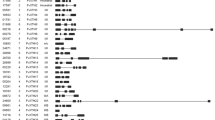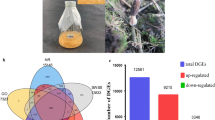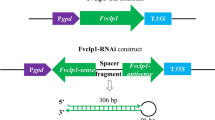Abstract
The formation of fruiting body in Volvariella volvacea is affected by endogenous genes and environmental factors. However, its regulation at a molecular level is still poorly understood. To study the genes involved in the formation of fruiting body, we cloned a new regulator of the G protein signaling (RGS) encoding gene (rgs) from V. volvacea. Phylogenetic analysis showed that RGS in V. volvacea and other basidiomycete RGS proteins from Schizophyllum commune and Coprinus cinereus belong to the same clade. In addition, we assayed intracellular cAMP content in the three developmental stages (mycelium, fruiting body primordia, and button). We also found that the expression of rgs was highly positively correlated to the content of intracellular cAMP during fruiting body formation. The conserved protein sequences and expression of rgs, together with high concent of cAMP at primordia tissue, suggested that rgs gene and cAMP may play a crucial role in fruiting body formation in V. volvacea.



Similar content being viewed by others
References
Bao D, Gong M, Zheng H, Chen M, Zhang L, Wang H, Jiang J, Wu L, Zhu Y, Zhu G, Zhou Y, Li C, Wang S, Zhao Y, Zhao G, Tian Q (2013) Sequencing and comparative analysis of the straw mushroom (Volvariella volvacea) genome. Plos one 8:e58294
Bölker M (1998) Sex and crime: heterotrimeric G proteins in fungal mating and pathogenesis. Fungal Genet 25:143–156
C’t Hoen PA, Ariyurek Y, Thygesen HH, Vreugdenhil E, Vossen RH, de Menezes RX, Boer JM, van Ommen GJ, den Dunnen JT (2008) Deep sequencing-based expression analysis shows major advances in robustness, resolution and inter-lab portability over five microarray platforms. Nucleic Acids Res 36:e141
Chang ST, Buswell JA (1996) Mushroom nutriceuticals. World J Microbiol Biotechnol 12:473–476
Chang ST, Yau CK (1971) Volvariella volvacea and its Life History. Am J Bot 58(6):552–561
Chen B, Gui F, Xie B, Deng Y, Sun X, Lin M, Tao Y, Li S (2013) Composition and expression of genes encoding carbohydrate-active enzymes in the straw-degrading mushroom Volvariella volvacea. Plos one 8:e58780
Chen SC, Ge W, Buswell JA (2004) Molecular cloning of a new laccase from the edible straw mushroom Volvariella volvacea: possible involvement in fruit body development. FEMS Microbiol Lett 230:171–176
Cui Z, Meng X, Wang C (2006) Research on HPLC method for check in cAMP in winter-date. Food Res Dev 27:158–159 Published in Chinese
Fowler TJ, Mitton MF (2000) Scooter, a new active transposon in Schizophyllum commune, has disrupted two genes regulating signal transduction. Genetics 156:1585–1594
Lalitha S (2000) Primer premier 5. Biotech Softw Internet Rep 1:270–272
Lee BN, Adams TH (1994) Overexpression of flbA, an early regulator of Aspergillus asexual sporulation, leads to activation of brlA and premature initiation of development. Mol Microbiol 14:323–334
Li H, Jiang H (2012) SPSS Data Analysis. Beijing, China. Published in Chinese
Liebmann B, Gattung S, Jahn B, Brakhage AA (2003) cAMP signaling in Aspergillus fumigatusis involved in the regulation of the virulence gene pksP and in defense against killing by macrophages. Mol Gen Genomics 269:420–435
Livak KJ, Schmittgen TD (2001) Analysis of relative gene expression data using real-time quantitative PCR and the 2−ΔΔCt method. Methods 25:402–408
Meng L, Yan J, Xie B, Li Y, Chen B, Liu S, Li D, Yang Z, Zeng X, Deng Y, Jiang Y (2013) Genes encoding FAD-binding proteins in Volvariella volvacea exhibit differential expression in homokaryons and heterokaryons. Microbiol Res 168:533–546
Mukherjee M, Kim JE, Park YS, Kolomiets MV, Shim WB (2011) Regulators of G-protein signalling in Fusarium verticillioides mediate differential host-pathogen responses on nonviable versus viable maize kernels. Mol Plant Pathol 12:479–491
Porebski S, Bailey LG, Baum BR (1997) Modification of a CTAB DNA extraction protocol for plants containing high polysaccharide and polyphenol components. Plant Mol Biol Rep 15:8–15
Quevillon E, Silventoinen V, Pillai S, Harte N, Mulder N, Apweiler R, Lopez R (2005) InterProScan: protein domains identifier. Nucleic Acids Res 33:116–120
Segers GC, Regier JC, Nuss DL (2004) Evidence for a role of the regulator of G-protein signaling protein CPRGS-1 in Gα subunit CPG-1-mediated regulation of fungal virulence, conidiation, and hydrophobin synthesis in the chestnut blight fungus Cryphonectria parasitica. Eukaryot Cell 3:1454–1463
Tamura K, Stecher G, Peterson D, Filipski A, Kumar S (2013) MEGA6: molecular evolutionary genetics analysis version 6.0. Mol Biol Evol 30:2725–2729
Tao Y, Xie B, Yang Z, Chen Z, Chen B, Deng Y, Jiang Y, van Peer AF (2013) Identification and expression analysis of a new glycoside hydrolase family 55 exo-β-1, 3-glucanase-encoding gene in Volvariella volvacea suggests a role in fruiting body development. Gene 527:154–160
Thompson JD, Gibson TJ, Plewniak F, Jeanmougin F, Higgins DG (1997) The clustal_x windows interface: flexible strategies for multiple sequence alignment aided by quality analysis tools. Nuleic Acids Res 25:4876–4882
Uno I, Ishikawa T (1973) Metabolism of adenosine 3′, 5′-cyclic monophosphate and induction of fruiting bodies in Coprinus macrorhizus. Bacteriology 113:1249–1255
Uno I, Yamaguchi M, Ishikawa T (1974) The effect of light on fruiting body formation and adenosine 3′:5′-Cyclic monophosphate metabolis in Coprinus macrorhizus. Proc Nat Acad Sci 71:479–483
Wang Y, Geng Z, Jiang D, Long F, Zhao Y, Su H, Zhang K, Yang J (2013) Characterizations and functions of regulator of G protein signaling (RGS) in fungi. Appl Microbiol Biotechnol 97:7977–7987
Xue C, Hsueh YP, Chen L, Heitman J (2008) The RGS protein Crg2 regulates both pheromone and cAMP signalling in Cryptococcus neoformans. Mol Microbiol 70:379–395
Yamagishi K, Kimur T, Suzuki M, Shinmoto H (2002) Suppression of fruit-body formation by constitutively active G-protein a-subunits ScGP-A and ScGP-C in the homobasidiomycete Schizophyllum commune. Microbiology 148:2797–2809
Zhang H, Tang W, Liu K, Huang Q, Zhang X, Yan X, Chen Y, Wang J, Qi Z, Wang Z, Zheng X, Wang P, Zhang Z (2011) Eight RGS and RGS-like proteins orchestrate growth, differentiation, and pathogenicity of Magnaporthe oryzae. PLoS Pathog 7:e1002450
Zhang J (2009) Industries science and development of edible fungi in China. Beijing. Published in Chinese
Zhang Z, Lin H, Ma B (2010) ZOOM Lite: next-generation sequencing data mapping and visualization software. Nucleic Acids Res 38:743–748
Zhong H, Neubig RR (2001) Regulator of G protein signaling proteins: novel multifunctional drug targets. J Pharmacol Exp Ther 297:837–845
Acknowledgments
This work was supported by grants from the National Key Basic Research Program of China (2014CB138302), and the China Agriculture Research System (CARS24). The authors thank the Fujian Edible Fungi Engineering Technology Research Center and the National Fungi Breeding Center (Fujian Branch) for providing the experimental facilities.
Author information
Authors and Affiliations
Corresponding author
Ethics declarations
Conflict of interest
The authors declare no conflict of interest.
Electronic supplementary material
Below is the link to the electronic supplementary material.
Rights and permissions
About this article
Cite this article
Lu, Y., Lian, L., Guo, L. et al. The Accordant Trend of Both Parameters (rgs Expression and cAMP Content) Follows the Pattern of Development of Fruiting Body in Volvariella volvacea . Curr Microbiol 71, 579–584 (2015). https://doi.org/10.1007/s00284-015-0885-8
Received:
Accepted:
Published:
Issue Date:
DOI: https://doi.org/10.1007/s00284-015-0885-8




